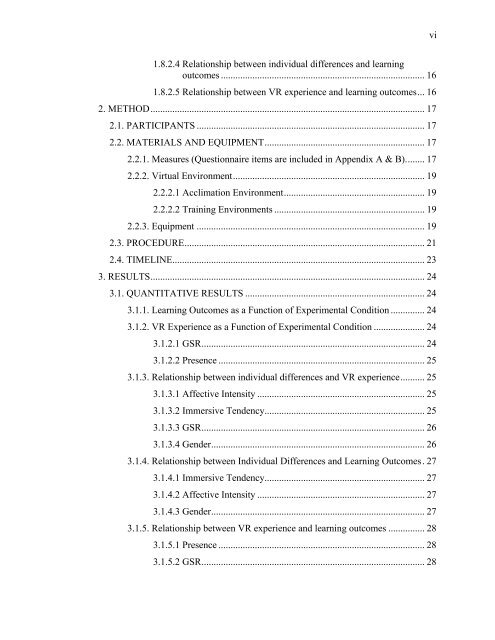Learning in Affectively Intense Virtual Environments - LITE
Learning in Affectively Intense Virtual Environments - LITE
Learning in Affectively Intense Virtual Environments - LITE
Create successful ePaper yourself
Turn your PDF publications into a flip-book with our unique Google optimized e-Paper software.
vi<br />
1.8.2.4 Relationship between <strong>in</strong>dividual differences and learn<strong>in</strong>g<br />
outcomes .................................................................................... 16<br />
1.8.2.5 Relationship between VR experience and learn<strong>in</strong>g outcomes... 16<br />
2. METHOD................................................................................................................. 17<br />
2.1. PARTICIPANTS .............................................................................................. 17<br />
2.2. MATERIALS AND EQUIPMENT.................................................................. 17<br />
2.2.1. Measures (Questionnaire items are <strong>in</strong>cluded <strong>in</strong> Appendix A & B)........ 17<br />
2.2.2. <strong>Virtual</strong> Environment............................................................................... 19<br />
2.2.2.1 Acclimation Environment.......................................................... 19<br />
2.2.2.2 Tra<strong>in</strong><strong>in</strong>g <strong>Environments</strong> .............................................................. 19<br />
2.2.3. Equipment .............................................................................................. 19<br />
2.3. PROCEDURE................................................................................................... 21<br />
2.4. TIMELINE........................................................................................................ 23<br />
3. RESULTS................................................................................................................. 24<br />
3.1. QUANTITATIVE RESULTS .......................................................................... 24<br />
3.1.1. <strong>Learn<strong>in</strong>g</strong> Outcomes as a Function of Experimental Condition .............. 24<br />
3.1.2. VR Experience as a Function of Experimental Condition ..................... 24<br />
3.1.2.1 GSR............................................................................................ 24<br />
3.1.2.2 Presence ..................................................................................... 25<br />
3.1.3. Relationship between <strong>in</strong>dividual differences and VR experience.......... 25<br />
3.1.3.1 Affective Intensity ..................................................................... 25<br />
3.1.3.2 Immersive Tendency.................................................................. 25<br />
3.1.3.3 GSR............................................................................................ 26<br />
3.1.3.4 Gender........................................................................................ 26<br />
3.1.4. Relationship between Individual Differences and <strong>Learn<strong>in</strong>g</strong> Outcomes. 27<br />
3.1.4.1 Immersive Tendency.................................................................. 27<br />
3.1.4.2 Affective Intensity ..................................................................... 27<br />
3.1.4.3 Gender........................................................................................ 27<br />
3.1.5. Relationship between VR experience and learn<strong>in</strong>g outcomes ............... 28<br />
3.1.5.1 Presence ..................................................................................... 28<br />
3.1.5.2 GSR............................................................................................ 28


